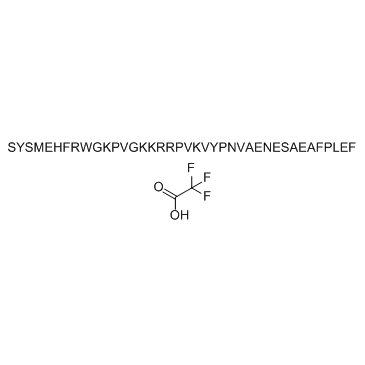Adrenocorticotropic Hormone (ACTH) (1-39), rat TFA (Synonyms: ACTH (1-39) (mouse, rat) TFA) |
| Catalog No.GC35255 |
Adrenocorticotropic Hormone (ACTH) (1-39), rat (TFA) is a potent melanocortin 2 (MC2) receptor agonist.
Products are for research use only. Not for human use. We do not sell to patients.

Sample solution is provided at 25 µL, 10mM.
Adrenocorticotropic Hormone (ACTH) (1-39), rat (TFA) is a potent melanocortin 2 (MC2) receptor agonist.
ACTH 1-39 at concentrations of 100-400 nM has no toxic effect on neurons, while ACTH provides protection from excitotoxic neuronal death induced by glutamate (100 μM), NMDA (1 mM), AMPA (50 μM), and kainate (25 μM). ACTH at 400 nM provides substantial protection in each case. ACTH at either 200 or 400 nM protects neurons from quinolinic acid (25 μM). There is also protection by ACTH from cell death induced by 2 μM H2O2, which gives rise to reactive oxygen species (ROS), with significantly more protection at 400 nM ACTH compared to 200 nM. ACTH gives modest protection against rapid release of nitric oxide (NO) by NOC-12 but not slow release by NOC-18. ACTH (200 or 400 nM) protects neurons from cytotoxic effects of staurosporine (10-20 nM), a classic inducer of cell death via apoptosis. ACTH reduces cell death from 80% to 55%[1].
The icv injection of ACTH significantly reduces cumulative food intake over the observation period compared with the saline/IgG group. The injection of ACTH Ab into the PVN abolishes the anorexigenic effect of ACTH. Infusion icv of ACTH significantly decreases cumulative food intake in rats that receive α-MSH Ab into the PVN and ACTH icv, and food intake is as low as in the group treated with ACTH icv and IgG into the PVN. Injection of either ACTH Ab or α-MSH Ab into the PVN significantly increase cumulative food intake compared with IgG-treated animals; the combined application of both Ab's do not increase food intake further[2].
[1]. Lisak RP, et al. Melanocortin receptor agonist ACTH 1-39 protects rat forebrain neurons from apoptotic, excitotoxic and inflammation-related damage. Exp Neurol. 2015 Nov;273:161-7. [2]. Schulz C, et al. Endogenous ACTH, not only alpha-melanocyte-stimulating hormone, reduces food intake mediated by hypothalamic mechanisms. Am J Physiol Endocrinol Metab. 2010 Feb;298(2):E237-44.
Average Rating: 5 (Based on Reviews and 16 reference(s) in Google Scholar.)
GLPBIO products are for RESEARCH USE ONLY. Please make sure your review or question is research based.
Required fields are marked with *




















